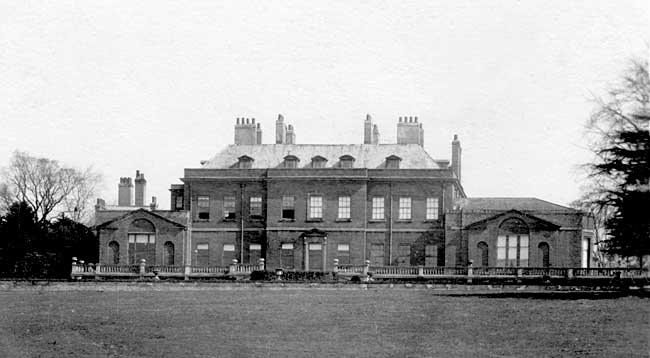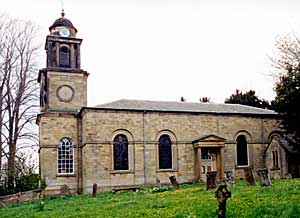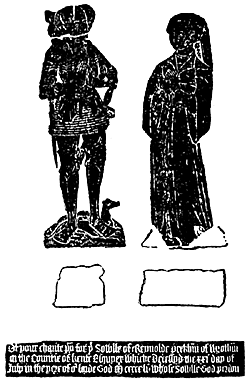Ossington

The west front of Ossington Hall, c.1910.
The manor of Ossington belonged to one named Osmund before the Conquest and to the de Buruns after it. Hugh de Burun, with the assent of his sons, Hugh and Roger, gave the church of Ossington to the monastery of Lenton in the year 1144, and this was confirmed by Roger de Burun at a later date. This Roger, however, appears to have given the manor and town of Ossington, apart from the church, to the Knights Hospitallers of St. John of Jerusalem, and this was confirmed by Walter in 1203. This state of things led to a lawsuit in 1208, between the Prior of Lenton and the Prior of the Hospitallers, both claiming the right of presenting to the church. The dispute was amicably settled by the Prior of Lenton relinquishing all claim to Ossington, and receiving as compensation from the Hospitallers a moiety of the advowson of “Huneswith.”
At the Dissolution, the manor and rectory of Ossington fell to Charles Brandon, Duke of Suffolk, who by royal licence in 1543 alienated it to Richard Andrewes, gent., from whom they passed to Edmund Cartwright, who for his second wife had married Rd. Andrewes’ daughter, Agnes (his first wife was Anne, sister of Thomas Cranmer, of Aslockton, Archbishop of Canterbury). This Edmund Cartwright died in 1553, and Ossington remained with his descendants until his line ended with four heirs female, who jointly sold it to William Denison, a wealthy merchant, who died in 1782, and with whose family it still continues.
In the report of Prior Philip de Thame to the Grand Master, Elyan de Villanova, made in 1338, we gather many particulars of the property of the Hospitallers at their preceptory of Ossington and the neighbouring “camera” of Winkburn. In the bailiwick or manor of Ossington they had a capital messuage with garden, value xvj’ viijd per annum, a dove cote of the annual value of xij’, 600 acres of land in demesne worth sixpence an acre, 32 acres of meadow worth two shillings an acre, pasture land in addition worth xxs a year, and two wind mills of the annual value of xls, the labour and customs of the natives was valued at £3 .19. 4, rent of cocks and hens at twenty shillings, and the annual value of the pleas and perquisites of the manor courts was assessed at forty shillings. There was also common of pasture at Ossington for twelve cows and 600 sheep, worth two shillings a cow and a penny a sheep, total £3.14. 0, there was an income of £24 a year from fixed rents, £22. 10 was voluntarily contributed by the freeholders, and the church was worth £8. 10. In addition to all this they had an estate at Thrumpton, in the Rushcliffe wapentake, worth ten marks a year, which was considered as part of the Ossington preceptory. This Thrumpton estate, however, they got licence, in 1351, to exchange for the manor of Dalby, in Leicestershire. Altogether the Ossington preceptory had an income of 142 marks 8s. and 4d. (or about £95) a year, a large sum in those days. Prior Philip’s report then gives particulars of the expenditure, which are most interesting, shewing the composition of the household and establishment maintained at Ossington. The expenses amounted to 116 mks. and 4d., so that there was an annual surplus for the treasury of 26 mks. 8s. Frater Risius Waleys, miles, was preceptor of Ossington at this date (1338), and the report is subscribed by him and Frater Thomas de Warenn, miles.
The “camera” of Winkburn, with its member of Deynilthorpe, of which also full details are given, is valued in this report at 93 mks. 8s. and 5d. per annum, and as it was not of the same rank and had not an establishment on the same scale as the preceptory, its expenditure was only 30 mks. 8s. 5d., leaving an annual surplus of 60 mks. for the treasury.

Church of the Holy Rood, Ossington was built by Carr of York, 1782-3. (© A P Nicholson, 2002).
The plain modern church of the Holy Rood stands on the site of an older fabric. The living is a donative. At the east end, one on either side of the altar, are two tombs from the older church. That on the north side is a costly Elizabethan monument, on the mensa of which, in the attitude of prayer, are the figures of William Cartwright and Grace, his wife, the youngest daughter and co-heiress of Thomas Dabridgcourt, of Langdon Hall, co. Warwick. The male figure is clad in a suit of plate armour, and the lady wears the ruff and costume of the period (she died 20th March, 1633). This William Cartwright was the eldest son of George Cartwright, who married Dorothy, daughter and heir of William Mollineux, of Haughton, co. Notts., widow of William Dabridgcourt, of Ossington, and was heir to his uncle, Hugh Cartwright, who was twice married but left no issue. Behind the figures are shields, showing the arms of Cartwright, Ermine, a fesse sable between three fire-balls of the last, enflamed proper, impaling the coat of Mollineux, azure, a cross moline or, with its quarterings; also another, Cartwright quartering Mollineux, and impaling Dabridgcourt, Ermine, three bars hummetée gides, with nearly a score of quarterings. On the front of the tomb, immediately below the figures, the arms of Mollineux, Cartwright, and Dabridgcourt are shown on separate shields. Below again, the six sons and six daughters, the offspring of this marriage, are represented by sculptured figures in two compartments. The Cartwrights of Ossington were an old Notts. family, and several were well-known to fame, vide Brown’s” Worthies and Celebrities of Notts.” Their pedigree is given both in Thoroton and in the Visitations of Notts. (Harleian Society). The other tomb on the south side of the altar is considerably older, and bears the brasses of Reginald Peckham and his lady.
Mr. J. Potter Briscoe, F.R.S.L., read the following paper:–

Monumental brass, Ossington Church.
In the Church of the Holy Rood at Ossington, is a monumental brass, which is not mentioned in Haines’ standard work on the subject. It is to the memory of Reynald Peckham and his spouse, is dated 1551, and lies upon an altar tomb just inside the chancel.
The brass comprises effigies of Peckham and his wife. Neither is in good condition. The head of the husband has been broken across, and a small portion of the bottom of the dress of the wife is missing. Below these figures are two matrixes, formerly containing two groups of children—that of the boys being below the feet of the father, and of the girls below the effigy of their mother. Nothing is known respecting their disappearance. Below these is a brass plate, the width of the two effigies, upon which there is an inscription in old English characters which reads:—

